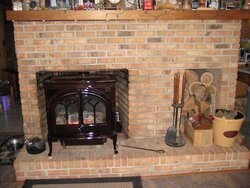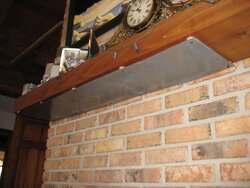I recently bought a Vogelzang Defender to use on those light heating days in the spring and fall when firing the beast in the basement (see avatar) is just too much. It's going in front of the fireplace (the gas logs are so outta here!) and I have a wood mantel that will be about 22"-23" above the top of the stove. I can not find a mantel clearance spec in the manual anywhere and I have read it cover to cover several times. The manual does have a section on installing the stove in a "fireplace install" and they do refer, via illustrated diagram, to a "mantel clearance reducer" but that is all there is, no measurements. Just an FYI, my mantel only hangs out past the stone of the fireplace 2-2.5"
So I emailed Vogelzang to get this spec, their response was "to contact my local HVAC store, to see what they say"?!

 WHAT THE...? Seriously?! I almost blew chocolate chip cookie chunks all over my computer when I first read their response (I was having my after work snack)
WHAT THE...? Seriously?! I almost blew chocolate chip cookie chunks all over my computer when I first read their response (I was having my after work snack)
You are the manufacturer and you tell your customer to go talk to some local yocal about what a combustible clearance should be on YOUR product?!
Anyways, rant over. Can anybody tell me what a "typical" clearance would be? Hey, asking the experts on hearth has to be at least (I'm sayin better than) as good as what they told me!
So I emailed Vogelzang to get this spec, their response was "to contact my local HVAC store, to see what they say"?!


 WHAT THE...? Seriously?! I almost blew chocolate chip cookie chunks all over my computer when I first read their response (I was having my after work snack)
WHAT THE...? Seriously?! I almost blew chocolate chip cookie chunks all over my computer when I first read their response (I was having my after work snack) You are the manufacturer and you tell your customer to go talk to some local yocal about what a combustible clearance should be on YOUR product?!
Anyways, rant over. Can anybody tell me what a "typical" clearance would be? Hey, asking the experts on hearth has to be at least (I'm sayin better than) as good as what they told me!








